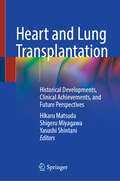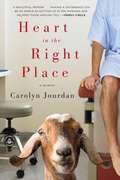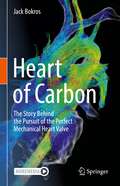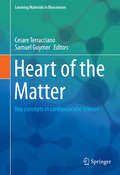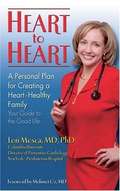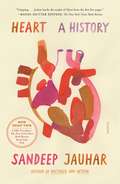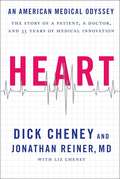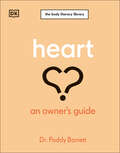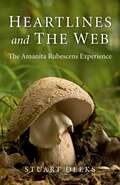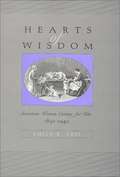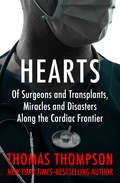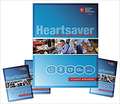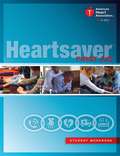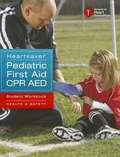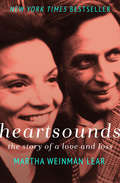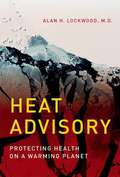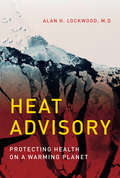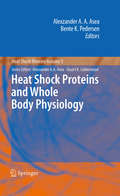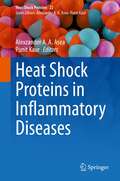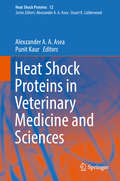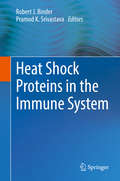- Table View
- List View
Heart and Lung Transplantation: Historical Developments, Clinical Achievements, and Future Perspectives
by Shigeru Miyagawa Hikaru Matsuda Yasushi ShintaniThis edited volume explores current research and future developments in transplantation medicine. Key sections include advances in organ preservation, mechanical circulatory support, and emerging fields such as organ transplantation from cardiac death donors (DCD), pediatric application of ventricular assist device (VAD), immunological tolerance and xenotransplantation. With contributions from leading U.S. experts in pediatric VAD therapy, DCD heart and lung transplantations, combined heart and kidney transplantation, the book provides a forward-looking perspective on how these innovations will transform the field. The book also details the historical journey of organ transplantation in Japan, from its early challenges to the significant revival of heart transplantation in 1999. It presents the impressive clinical results achieved at the First Department of Surgery at Osaka University Medical School. Heart and lung transplantation: Historical Developments, Clinical Achievements, and Future Perspectives is essential reading for medical professionals, researchers, and students interested in the latest advances and future directions in organ transplantation.
Heart in the Right Place
by Carolyn JourdanCarolyn Jourdan, an attorney on Capitol Hill, thought she had it made. But when her mother has a heart attack, she returns home--to the Tennessee mountains, where her father is a country doctor and her mother works as his receptionist. Jourdan offers to fill in for her mother until she gets better. But days turn into weeks as she trades in her suits for scrubs and finds herself following hazmat regulations for cleaning up bodily fluids; maintaining composure when confronted with a splinter the size of a steak knife; and tending to the loquacious Miss Hiawatha, whose daily doctor visits are never billed. Most important, she comes to understand what her father really means to this close-knit community.With great tenderness and great humor, "Heart in the Right Place" shows that some of our biggest heroes might be the ones living right beside us.
Heart of Carbon: The Story Behind the Pursuit of the Perfect Mechanical Heart Valve
by Jack BokrosThis book offers a historical account of the development of the On-X carbon mechanical heart valve, discussing the steps involved in developing the materials, and describes how the design of the valve has evolved over the years. It explores both the scientific and corporate problems researchers have encountered over the years in the journey of making a mechanical heart valve. The chapters provide a detailed description of the design of the mechanical leaflet-based prosthetic valve, with a particular focus on blood flow characteristics. This book includes an overview of the state-of-the-art in the chemistry and physics of carbon, and compiles the advances in carbon-based technology and its applications in cardiac and thoracic surgery.This is an ideal book for bioengineers working on the chemistry and physics of carbon, and other professionals involved with cardiac and thoracic surgery.
Heart of the Matter: Key concepts in cardiovascular science (Learning Materials in Biosciences)
by Cesare Terracciano Samuel GuymerThis textbook introduces readers to the scientific basics of cardiovascular medicine and biology. It covers not only developmental but also cellular and molecular aspects of normally functioning vasculature and the heart; importantly, it also addresses the mechanisms leading to and involved in specific cardiovascular diseases. Though the main emphasis is on novel therapies and potential therapeutic targets, specific controversial topics like cardiac remodeling and regenerative capacities are also addressed. All chapters were written by lecturers from the Imperial College London, in collaboration with their students from the College’s BSc Programme in Medical Sciences with Cardiovascular Science. Bridging the gap between clinics and basic biology, the book offers a valuable guide for medical students, and for Master and PhD students in Cardiovascular Biomedicine.
Heart to Heart: Your Guide to the Good Life
by Lori MoscaInformation meets inspiration for today's busy spouse, parent, caregiver, provider... and everything else you're expected to be. You worry about your father's bad habits. Your mother's refusal to listen to her doctor. Your spouse's cholesterol. Your children's diet. For better or worse, you're the center of your family's universe and the person trying desperately to keep them all healthy. As if you weren't busy enough! Dr. Lori Mosca is not only one of America's top doctors; she is also a wife, a mother and a daughter. She's been where you're standing, and her message is simple: To improve your family's health, you have to start with yourself. And there are three steps to do it. Know It. Knowledge is power. This goes beyond diet and fitness to stress management, personal fulfillment, daily attitude and spiritual practice. Happiness and health are not mutually exclusive. Nurture It. Take care of your heart, but also your soul. Don't deprive yourself of what makes your life enjoyable. Nurture the better, healthier parts of your routine. Gradually incorporate changes that make you healthy, happy and vital. Share It. Lead by example and your family will follow. Have healthy fun together and share not just your knowledge but your time. A healthy heart isn't another item on your to do list, but a new attitude that will make life easier-and give you more time and energy to share with those you love. Dr. Lori Mosca has helped thousands take control of their lives and their health. Her proven program for family heart health is transforming the practice of medicine in hospitals and doctors' offices across the nation. Now let it transform you and your family--for life!
Heart, Brain and Mental Health Disparities for LGBTQ People of Color
by James J. GarcíaThis timely edited collection presents a holistic and biopsychosocial analysis of LGBTQ People of Color well-being, focused on heart, brain, and mental health, and employs a unique incorporation of minority stress, intersectionality, and allostatic load frameworks.Bringing together established and emerging academics, its authors present a critical analysis of the latest research that encompasses the study of both risk and resilience factors in LGBTQ People of Color health. Across the book, they highlight the precise nature of the behavioral health disparities experienced by these communities, but further, they reveal the unique roles of intersectional discrimination and structural stigma as mechanisms for these disparities.With chapters also dedicated to federal policies and public health, this multidisciplinary work marks a seminal contribution that will pave the way for further advances in research, theory, and practice. It offers a valuable resource on an understudied population that will appeal to researchers, practitioners and policy makers in the fields of health psychology, public health, epidemiology, sociology, health sciences and medicine.
Heart: A History
by Sandeep JauharThe bestselling author of Intern and Doctored tells the story of the thing that makes us tick <P><P>For centuries, the human heart seemed beyond our understanding: an inscrutable shuddering mass that was somehow the driver of emotion and the seat of the soul. As the cardiologist and bestselling author Sandeep Jauhar shows in Heart: A History, it was only recently that we demolished age-old taboos and devised the transformative procedures that have changed the way we live. <P><P>Deftly alternating between key historical episodes and his own work, Jauhar tells the colorful and little-known story of the doctors who risked their careers and the patients who risked their lives to know and heal our most vital organ. He introduces us to Daniel Hale Williams, the African American doctor who performed the world’s first open heart surgery in Gilded Age Chicago. We meet C. Walton Lillehei, who connected a patient’s circulatory system to a healthy donor’s, paving the way for the heart-lung machine. And we encounter Wilson Greatbatch, who saved millions by inventing the pacemaker—by accident. <P><P>Jauhar deftly braids these tales of discovery, hubris, and sorrow with moving accounts of his family’s history of heart ailments and the patients he’s treated over many years. He also confronts the limits of medical technology, arguing that future progress will depend more on how we choose to live than on the devices we invent. Affecting, engaging, and beautifully written, Heart: A History takes the full measure of the only organ that can move itself.
Heart: An American Medical Odyssey
by Dick Cheney Jonathan ReinerFormer Vice President Dick Cheney and his longtime cardiologist, Dr. Jonathan Reiner, share the story of Cheney&’s thirty-five-year battle with heart disease—providing insight into the incredible medical breakthroughs that have changed cardiac care over the last four decades.For as long as he has served at the highest levels of business and government, Vice President Dick Cheney has also been one of the world&’s most prominent heart patients. Now, for the first time ever, Cheney, together with his longtime cardiologist, Jonathan Reiner, MD, shares the very personal story of his courageous thirty-five-year battle with heart disease, from his first heart attack in 1978 to the heart transplant he received in 2012. In 1978, when Cheney suffered his first heart attack, he received essentially the same treatment President Eisenhower had had in 1955. Since then, cardiac medicine has been revolutionized, and Cheney has benefitted from nearly every medical breakthrough. At each juncture, when Cheney faced a new health challenge, the technology was one step ahead of his disease. Cheney&’s story is in many ways the story of the evolution of modern cardiac care. Heart is the riveting, singular memoir of both doctor and patient. Like no US politician has before him, Cheney opens up about his health struggles, sharing harrowing, never-before-told stories about the challenges he faced during a perilous time in our nation&’s history. Dr. Reiner provides his perspective on Cheney&’s case and also gives readers a fascinating glimpse into his own education as a doctor and the history of our understanding of the human heart. He masterfully chronicles the important discoveries, radical innovations, and cutting-edge science that have changed the face of medicine and saved countless lives. Powerfully braiding science with story and the personal with the political, Heart is a sweeping, inspiring, and ultimately optimistic book that will give hope to the millions of Americans affected by heart disease.
Heart: An Owner's Guide (The Body Literacy Library)
by Paddy BarrettBecome body literate with Heart: An Owner's Guide, the next book in The Body Literacy Library, a helpful series that will break down heart health for a new generation of readers.Heart: An Owner's Guide is an informative, practical, and engaging introduction to all aspects of heart health to live well and longer. Find the key to a long, healthy life and your cardiac risk.Author Dr Paddy Barrett is an engaging and media-friendly Consultant Cardiologist specializing in preventative health care. He translates medical jargon into simple, straightforward prose, answering frequently asked patient queries, such as Should I take aspirin? Are heart attacks hereditary? Is red wine healthy? And much more.In this book, you can find:-Easy-to-follow science and lifestyle advice with simple Q&As. -Illustrations with data-driven images that show how certain lifestyle choices impact your health.-Best tips to help you know how to best care for your body and heart.-Chapters that outline the vital organ and how it works, risks for heart problems, and what to do to improve heart health. From what you should eat (or not) and exercising smarter to why stress is as dangerous as smoking, this hard-working book applies science to the everyday, with simple illustrations, checklists, FAQs, and myth busters, all supported by the latest medical research. Heart: An Owner's Guide won't just help you understand your body better.
Heart: Shortlisted for the Wellcome Book Prize 2019
by Sandeep Jauhar&‘Jauhar weaves his own personal and family story into his history of the heart…very effectively… This gives a certain dramatic tension to the book, as it tells the fascinating and rather wonderful history of cardiology.&’ –Henry Marsh, New StatesmanA Mail on Sunday Book of the Year The heart lies at the centre of life. For cardiologist Sandeep Jauhar it is an obsession. In this fascinating history he interweaves gripping scenes from the operating theatre with the moving tale of his family&’s history of heart problems – from the death of his grandfather to the ominous signs of how he himself might die. Jauhar looks at the pioneers who risked patients&’ lives and their own careers, and confronts the limits of medical technology, arguing that how we live is more important than any device or drug we may invent. Heart is the all-encompassing story of the engine of life.
Heart: The Inside Story of Our Body's Most Heroic Organ
by Johannes Hinrich von Borstel&“Describes the physiology behind the normal function of the heart with gusto and humor . . . well informed and accessible . . . a necessary book.&” —Readings In this lively and informative exploration of all aspects of the heart, Johannes Hinrich von Borstel offers a perfect mix of medical fact and amusing anecdote. A doctor, prospective cardiologist, and former paramedic—as well as a successful science-slammer—von Borstel relates his own experiences to provide a personal insight into the human side of heart medicine, while clearly explaining the science behind cardiac disease and healthcare for the heart. His many tips on how to give your ticker the best chance of enduring for as long as possible include one that will certainly be close to many people&’s hearts: have more sex! Oh, and eat more vegetables. &“Whether your heart is healthy or not, everyone should read this book, because the author has truly put his heart and soul into it.&” —Shelf Life &“While von Borstel cautions against these excesses, his youthful enthusiasm and gusto for his subject makes for a lively read.&” —The Sydney Morning Herald &“An eminently readable book which strikes a very good balance between information and anecdote . . . should be of interest to anyone who wants to know what goes on &‘under the hood&’ as it were, regardless of your level of anatomical understanding . . . this is a marvelous book.&” —Yinspire
Heartlines and The Web: The Amanita Rubescens Experience
by Stuart DeeksI find a fungus one autumn in a grassy area of a town park. I identifiy it as Amanita Rubescens, the Blusher. I cook and eat it. It affects me, the ripples begin. I am curious to know more. Others get involved. It is prepared as a medicine at a homoeopathic pharmacy, then a group take part in a trial, a Proving. We clarify its medicinal potential. This is then confirmed in homoeopathic practice. Found, tested, prescribed. This book tells this story and indicates the scope and impact of the medicine. We see its relevance for people at the present time. It is needed. Purification. Cleansing. Clearing physical and mental toxic states. Speaking up about long held hurts, personal or national. Parallels with the Arab Spring and other recent demonstrations. Alignment, personal and planetary. The web that connects everything, impelling a radical healing of the heart.
Hearts of Wisdom: American Women Caring for Kin, 1850-1940
by Emily K. AbelDrawing upon a wealth of diaries, letters, and case records from hospitals and social service agencies, the author examines the shifting roles of caregivers between 1850 and 1940. In addition to the diaries and letters of literate white woman, she turns to slave narratives from the antebellum south and records from health-care agencies serving American Indians during the first part of the 20th century. Abel shows that women in the 19th century gained self-esteem and status through their knowledge of home remedies and nursing techniques. The medical profession gained strength with the discovery of microbes and the development of medications to treat specific diseases. During the 20th century professionals discredited women who provided health care at home. One chapter discusses mothers of children with epilepsy or mental retardation, who were pressured to place their children in institutions and to sever emotional ties with them. Another chapter explores the shift from American sign language to oralism in the education of deaf children, and the impact this had upon mothers. Abel concludes by looking briefly at the current trend to return more and more caregiving to the home.
Hearts: Of Surgeons and Transplants, Miracles and Disasters Along the Cardiac Frontier
by Thomas ThompsonPioneer heart surgeons and bitter rivals: The &“thoroughly engrossing&” true story of doctors Michael DeBakey and Denton Cooley (The New York Times Book Review). By 1970, the Texas Medical Center in Houston was the leading heart institute in the world, home to the field&’s two most distinguished surgeons: Dr. Michael Ellis DeBakey and his young and ambitious disciple, Dr. Denton Arthur Cooley. Their combined mastery in occlusive disease, coronary artery bypass surgery, angioplasty, and heart transplants was unparalleled. For years they worked across the same operating table focused on, and fighting toward, the same lifesaving goals. But what began as a personal friendship and a mutually respectful professional partnership soon deteriorated into a jealous and embittered feud. Though their discord was a cause célèbre among colleagues, it would take award-winning investigative journalist Thomas Thompson to uncover the stunning betrayals and simmering resentments that fueled one of the most famous rivalries in the history of medicine. Weaving the story of DeBakey and Cooley with the stories of patients suffering life-threatening medical conditions, Thompson paints a fascinating portrait of the risks and rewards of cutting-edge science. From devastating tragedies to miraculous breakthroughs, Hearts is a richly detailed and utterly &“compelling&” account of the turmoil and tension behind one of the greatest medical achievements of the twentieth century (Time).
Heartsaver First Aid CPR AE3D Student Workbook
by American Heart AssociationThe Heartsaver First Aid CPR AED Student Workbook is for use by a single user as a student reference tool before, during, and after the course.
Heartsaver First Aid Student Workbook 2015
by American Heart AssociationThe Heartsaver First Aid Student Workbook is for use by a single user as a student reference tool before, during, and after the course.
Heartsaver: Pediatric First Aid CPR AED (Student Workbook)
by The Editors at the American Heart AssociationThis course provides a framework for learning basic skills that may save a life or prevent further injury of an infant or child.
Heartsaver® Bloodborne Pathogens Student Workbook
by American Heart AssociationThe Heartsaver® Bloodborne Pathogens course teaches employees how to protect themselves and others when confronted with blood or blood-containing materials. The course is designed specifically for workers who have a reasonable chance of contact with bloodborne pathogens, including correctional officers, childcare workers, security guards, maintenance workers, school personnel, hotel housekeepers, health and fitness club staff, and tattoo artists. The Heartsaver Bloodborne Pathogens course uses the PACT™ acronym (Protect, Act, Clean, Tell) and the slogan, "Make a PACT, Know How to Act," to help students learn and easily recall bloodborne pathogens training. It also helps employers meet OSHA requirements for bloodborne pathogens training when paired with site-specific instruction.
Heartsounds: The Story of a Love and Loss
by Martha Weinman LearThe national bestseller and undying testament of a wife&’s love for her husband as he embarks on the fight of his life. On a story assignment in France for the New York Times Magazine, Martha Weinman Lear has just escaped tourist-infested Cannes for a quiet pension in the hills behind the Riviera when she gets the call from New York. Her husband has suffered a massive heart attack and is in the hospital. Harold Lear, a fifty-three-year-old urologist and leader in the field of human sexuality research, suddenly finds himself in the helpless role of the patient. Ripping into the Lears&’ lives and marriage, Hal&’s coronary disease sends them on a journey through New York City&’s medical maze. With bittersweet poignancy, Lear chronicles her husband&’s valiant efforts to combat his sickness as more heart attacks and devastating postsurgical complications befall him. A stunning work of medical drama and journalism, Heartsounds is above all the gripping story of a passionate, enduring love.
Heat Advisory: Protecting Health on a Warming Planet
by Alan H. LockwoodClimate change affects not just the planet but the people who live on it. In this book, physician Alan Lockwood describes how global warming will be bad for our health. Drawing on peer-reviewed scientific and medical research, Lockwood meticulously details the symptoms of climate change and their medical side effects. Our global ecosystems create webs of interdependence that support life on the planet. Lockwood shows how climate change is affecting these ecosystems and describes the resulting impact on health. For example, rising temperatures create long-duration heat waves during which people sicken and die. Climate change increases the risk for certain infectious diseases, including malaria, dengue fever, West Nile virus, Zika, and Lyme disease. Extreme weather and poor soil conditions cause agricultural shortfalls, leading to undernutrition and famine. There is even evidence that violence increases in warmer weather -- including a study showing that pitchers throw "beanballs" (balls thrown with the intention of hitting the batter) significantly more often in hot weather.Climate change is real and it is happening now. We must use what we know to adapt to a warmer world and minimize adverse health effects: make city buildings cooler with air conditioning and "cool roofs," for example, and mobilize resources for predicted outbreaks of disease. But, Lockwood points out, we also need prevention. The ultimate preventive medicine is reducing greenhouse gas emissions and replacing energy sources that depend on fossil fuels with those that do not.
Heat Advisory: Protecting Health on a Warming Planet
by Alan H. LockwoodHow climate change can affect our health, from heat-related illnesses to extreme weather events.Climate change affects not just the planet but the people who live on it. In this book, physician Alan Lockwood describes how global warming will be bad for our health. Drawing on peer-reviewed scientific and medical research, Lockwood meticulously details the symptoms of climate change and their medical side effects. Our global ecosystems create webs of interdependence that support life on the planet. Lockwood shows how climate change is affecting these ecosystems and describes the resulting impact on health. For example, rising temperatures create long-duration heat waves during which people sicken and die. Climate change increases the risk for certain infectious diseases, including malaria, dengue fever, West Nile virus, Zika, and Lyme disease. Extreme weather and poor soil conditions cause agricultural shortfalls, leading to undernutrition and famine. There is even evidence that violence increases in warmer weather—including a study showing that pitchers throw “beanballs” (balls thrown with the intention of hitting the batter) significantly more often in hot weather.Climate change is real and it is happening now. We must use what we know to adapt to a warmer world and minimize adverse health effects: make city buildings cooler with air conditioning and “cool roofs,” for example, and mobilize resources for predicted outbreaks of disease. But, Lockwood points out, we also need prevention. The ultimate preventive medicine is reducing greenhouse gas emissions and replacing energy sources that depend on fossil fuels with those that do not.
Heat Shock Proteins and Whole Body Physiology
by Alexzander A. Asea Bente K. PedersenHeat Shock Proteins and Whole Body Physiology is an exciting new book in the Heat Shock Proteins series which provides the most up-to-date review on novel mechanisms insights into the important role played by heat shock proteins in human physiology. Written by leaders in the field of heat shock protein exercise physiology, neuroscience and aging, the chapters systematically and in a step wise fashion takes the reader through the fascinating mechanisms by which heat shock proteins modulate human disease and pathophysiology and provides answers as to its biological significance to the host. Section I, introduces the readers to the role played by heat shock proteins in various diseases and disorders (Heat Shock Proteins and Disease). Section II, addresses the role heat shock proteins play in psychological disorders including post traumatic stress disorders and learning (Heat Shock Proteins and Psychological Stress). Section III, present a detailed review of the role played by heat shock proteins in exercise physiology (Heat Shock Proteins and Exercise Physiology). This book is a must read for heat shock protein researchers, graduate and postgraduate fellows in the field of Medicine in general and specialities in Excersie Physiology, Neuroscience, Immunology, Aging and Pathology.
Heat Shock Proteins in Inflammatory Diseases (Heat Shock Proteins #22)
by Alexzander A. A. Asea Punit KaurThe book Heat Shock Proteins in Inflammatory Diseases provides the most comprehensive highlight and insight of the expression, function and therapeutic activity of Heat Shock Proteins in inflammatory diseases including sepsis, psoriasis, neurodegenerative diseases, cancers, viral infection and autoimmune rheumatic diseases. Using an integrative approach, the contributors provide a synopsis of the most current updates on the state of HSP in inflammatory diseases.Key basic and clinical research laboratories from major universities, academic medical hospitals, biotechnology and pharmaceutical laboratories around the world have contributed chapters that review present research activity and importantly project the field into the future. The book is a must read for graduate students. medical students, basic science researchers and postdoctoral scholars in the fields of Cancer Biology, Oncology, Translational Medicine, Clinical Research, Biotechnology, Cell & Molecular Medicine, Pharmaceutical Scientists and Researchers involved in Drug Discovery.
Heat Shock Proteins in Veterinary Medicine and Sciences: Published under the Sponsorship of the Association for Institutional Research (AIR) and the Association for the Study of Higher Education (ASHE) (Heat Shock Proteins #12)
by Alexzander A. A. Asea Punit KaurThis books provides up-to-date reviews on current advances of the role of HSP in veterinary medicine and research. Key basic and clinical research laboratories from major universities, veterinary hospitals and pharmaceutical companies around the world have contributed chapters that review present research activity and importantly project this field into the future. For easy readability, the book is sub divided into sections on HSP in the following aspects of Veterinary Medicine, including, I - Domestic Animals, II - Poultry, III - Aquatic and IV - Parasites. The book is a must read for heat shock protein researchers in general and specifically those involved in clinical and research in veterinary medicine.
Heat Shock Proteins in the Immune System
by Robert J. Binder Pramod K. SrivastavaExperts from around the world review the current field of the immunobiology of heat shock proteins, and provide a comprehensive account of how these molecules are spearheading efforts in the understanding of various pathways of the immune system. This one-stop resource contains numerous images to both help illustrate the research on heat shock proteins, and better clarify the field for the non-expert. Heat shock proteins (HSPs) were discovered in 1962 and were quickly recognized for their role in protecting cells from stress. Twenty years later, the immunogenicity of a select few HSPs was described, and for the past 30 years, these findings have been applied to numerous branches of immunology, including tumor immunology and immunosurveillance, immunotherapy, etiology of autoimmunity, immunotherapy of infectious diseases, and expression of innate receptors. While HSPs can be used to manipulate immune responses by exogenous administration, they appear to be involved in initiation of de novo immune responses to cancer and likely in the maintenance of immune homeostasis.
